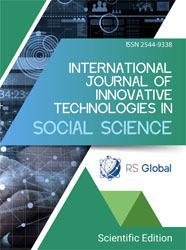DRINKING WATER SUPPLY ISSUES: MODELLING AND INTEGRATED MANAGEMENT FOR FUTURE SUSTAINABILITY. THE CASE OF THE CITY OF GUELMA, NORTH-EAST ALGERIA
Abstract
The city of Guelma has experienced remarkable urban sprawl over the last few decades, with a continuous expansion of the urban area to accommodate a growing population. This phenomenon is particularly accentuated by a high demographic growth rate, which increases the pressure on infrastructure and basic services, especially drinking water supply, due to the increasing needs of households. The main objective of this study is to analyse the contribution of the WEAP model to the management of drinking water supply in the different sectors of the city of Guelma. This approach aims to ensure effective and sustainable planning of water resources to meet the growing needs of the population in each sector, while preserving this essential resource. The results show that water resources are limited, with projected consumption increasing from 6 million m³ in 2008 to around 47 million m³ in 2050, while the population is expected to reach almost 800,000 inhabitants. All scenarios show a water deficit, where demand exceeds supply. The study therefore emphasises the need for integrated water resource management to ensure sustainability. It uses hydrological and demographic data to guide supply decisions and aims to develop effective strategies to address the growing water challenges in the city of Guelma.
References
Chebbani, R., Djilli, K., & Roose, E. (1999). Study at different scales of erosion risks in the Isser watershed, Algeria. Bulletin of the Erosion Network, 19, pp. 85-95.
HASSAN D.., RAIS M.N., AHMED W., BANO R., BURIAN S.J., IJAZ M.W., BHATTI F.A. 2019. Future water demand modeling using water evaluation and planning: A case study of the Indus Basin in Pakistan. Sustainable Water Resources Management. Vol. 5 p. 1903–1915. DOI 10.1007/s40899-019-00343-0.
Höllermann, B., Giertz, S. &Diekkrüger, B. Benin (2010). 2025—Balancing Future Water Availability and Demand Using the WEAP ‘Water Evaluation and Planning’ System. Water Resources Management, 24, 3591–3613 https://doi.org/10.1007/s11269-010-9622-z
Husain S.A., Rhyme N.H.M. (2021). Decision Support Method for Agricultural Irrigation Scenarios Performance Using WEAP Model. In: Abdul Karim S.A. (eds) Theoretical, Modelling and Numerical Simulations Toward Industry 4.0. Studies in Systems, Decision and Control, 319. Springer, Singapore. https://doi.org/10.1007/978-981-15-8987-4
Mensah J.K., Ofosua E. A., Akpotid K., Kabo-Bah A.T., Okyereha S.A., Yidana S.M. (2022). Modelling current and future groundwater demands in the White Volta River Basin of Ghana under climate change and socio-economic scenarios. Journal of Hydrology: Regional Studies, Vol. 41, June 2022, pp. 78–88.
Ouamane, A. (2009). Dam engineering in Algeria: progress, needs and prospects. The International Journal on Hydropower & Dams, 16(6), pp. 75-79.
Psomas, A., Panagopoulos, Y., Stefanidis, K., & Mimikou, M. (2017). Assessing future water supply and demand in a water-stressed catchment after environmental restrictions on abstractions. Journal of Water Supply: Research and Technology - Aqua, jws2017130, pp. 1-13.
Remini, B., & Hallouche, W. (2005). Prediction of sedimentation in Maghreb dams. Larhyss Journal, 4, pp. 69-80.
Remini, B. (2017). A new approach to managing dam sedimentation. Larhyss Journal, 31, pp. 51-81
SEI (2008) WEAP (Water Evaluation and Planning) : Guide d'utilisation pour WEAP-21. Stockholm Environment Institute, Boston.Soc. Civ. Eng. 81, 695–721.
SEI (2016) Water Evaluation and Planning System (WEAP) Tutorial Modules. A collection of stand-alone modules to aid in learning the WEAP software. USA.
Seiber, J., Swartz, C., & Huber-Lee, A. (2005). User guide for WEAP21, Stockholm Environment Institute, Tellus Institute, 176 pp.
Shiklomanov, I. A., Rodda J. C. (2003). World water resources at the beginning of the twenty-first century. Cambridge, UK, Cambridge University Press.
Singh, A. (2014). Conjunctive use of water resources for sustainable irrigated agriculture. Journal of Hydrology, 519, 1688–1697.
Thompson T et al (2007) Chemical safety of drinking-water: assessing priorities for risk management. WHO publication, Geneva.
United Nations, 2018. "The World’s Cities in 2018: Data Booklet." United Nations, Department of Economic and Social Affairs, Population Division.
WEAP 16 : (http://www.weap16.org/).
WEAP 17 : (http://www.weap17.org/).
WEAP 21 : (http://www.weap21.org/).
Water Resources Department Data (2023) Data on distributed water quantities. Water Resources Department, Guelma Region
YATES D., PURKEY D., SIEBER J., HUBER-LEE A., GALBRAITH H. 2005. Weap21-a demand-, priority-, andpreference-driven water planning model: P. 2. Aiding freshwater ecosystem service evaluation. Water International. Vol. 30. Iss. 4 p. 501–512. DOI 10.1080/02508060508691894.
Yazdanpanah, T., Khodashenas, S. R., Davari, K., Ghahraman, B. (2008). Water resources management in a Watershed with WEAP model (A case study of Azghad watershed). Journal of Agriculture Science and Technology, 22 (1), 213–221.
Views:
156
Downloads:
84
Copyright (c) 2024 Bennacer Leila, Benmechiche M., Boubguira S., Hami M., Nouar T.

This work is licensed under a Creative Commons Attribution 4.0 International License.
All articles are published in open-access and licensed under a Creative Commons Attribution 4.0 International License (CC BY 4.0). Hence, authors retain copyright to the content of the articles.
CC BY 4.0 License allows content to be copied, adapted, displayed, distributed, re-published or otherwise re-used for any purpose including for adaptation and commercial use provided the content is attributed.















